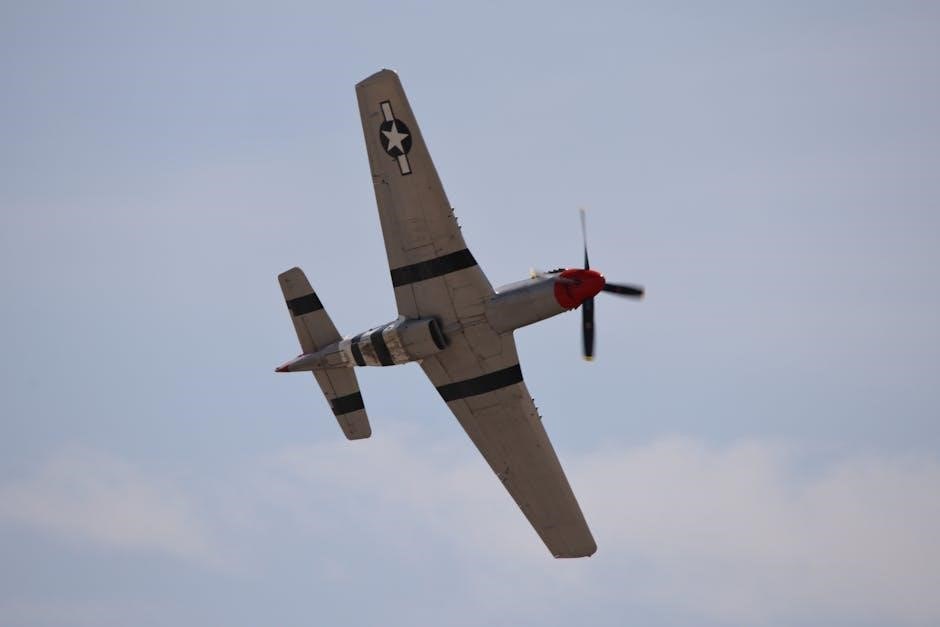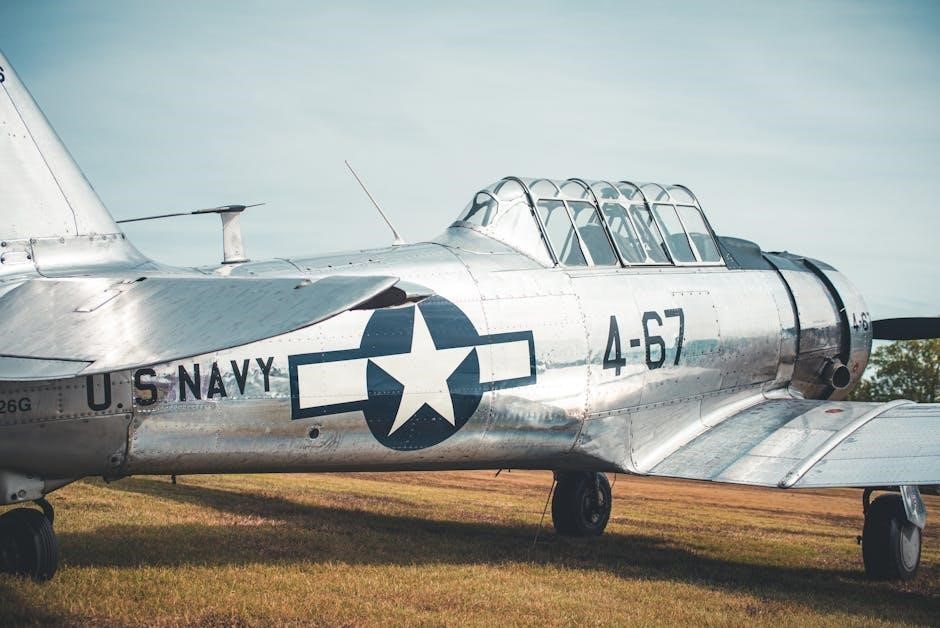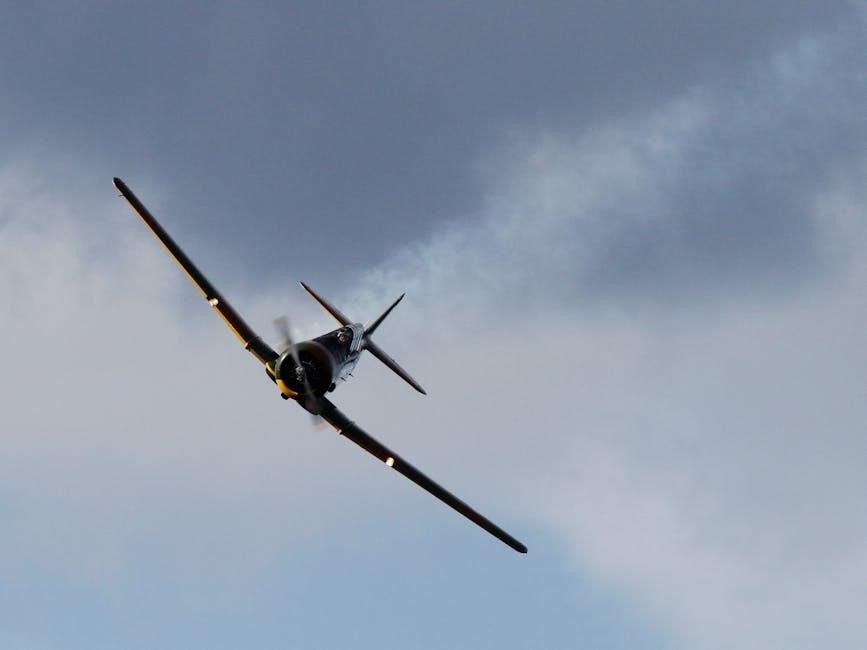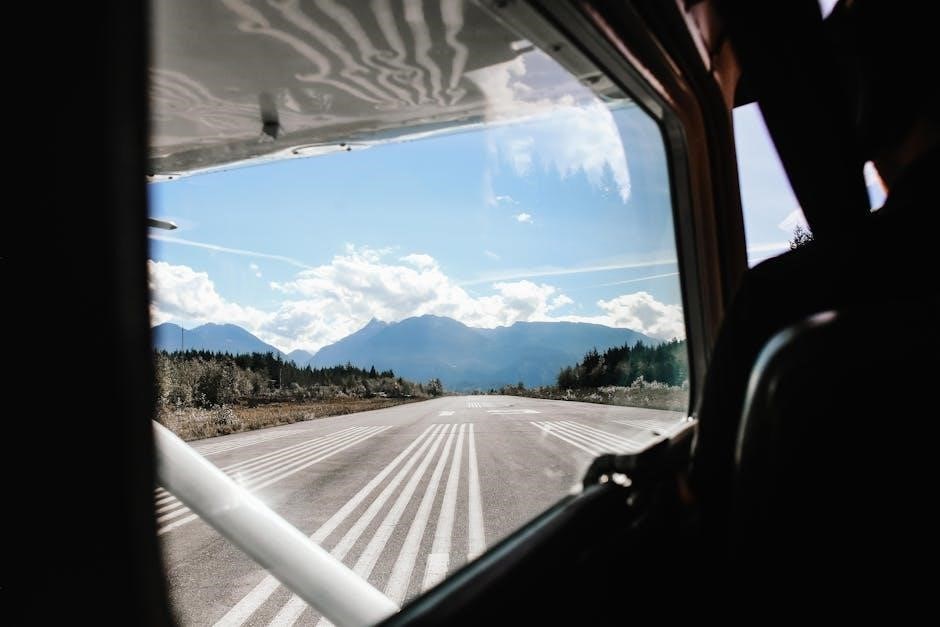World War II aircraft played a pivotal role in shaping the conflict, showcasing technological advancements, strategic innovations, and diverse roles in combat and logistics.
1.1 Historical Context and Importance of Aircraft in WWII
World War II marked a turning point in aviation history, as aircraft became central to military strategy and tactics. Airpower determined the outcome of battles, enabled long-range attacks, and facilitated logistics. Technological advancements like radar and jet engines emerged, while iconic planes like bombers and fighters revolutionized warfare. The shift from limited air capabilities in WWI to the dominance of air superiority in WWII underscored its critical role in shaping global conflict outcomes.
1.2 Major Types of WWII Aircraft
WWII aircraft were diverse, serving various roles such as combat, transport, and reconnaissance. Fighters like the Spitfire and Mustang excelled in dogfights, while bombers like the B-17 and B-29 conducted strategic missions. Transport planes and gliders enabled troop deployments and supply drops. Each type played a crucial role in shaping air warfare tactics and influencing the war’s outcome, reflecting rapid technological advancements and strategic adaptability during the conflict.
Fighters and Bombers
WWII fighters and bombers were central to air warfare, with fighters ensuring air superiority and bombers executing strategic missions, both pivotal in determining the war’s outcome.
2.1 Iconic Fighter Planes: Spitfire, Mustang, and Messerschmitt
The Supermarine Spitfire, North American P-51 Mustang, and Messerschmitt Bf 109 were iconic WWII fighters. The Spitfire symbolized British resilience, while the Mustang’s range boosted Allied bombing campaigns. The Bf 109, a backbone of the Luftwaffe, dominated early war skies. Each design reflected national priorities, with innovations like Rolls-Royce Merlin engines for the Spitfire and the Mustang’s laminar flow wings enhancing performance. Their duels shaped air superiority.
2.2 Strategic Bombers: B-17, B-29, and Lancaster
The Boeing B-17 Flying Fortress, B-29 Superfortress, and Avro Lancaster were legendary strategic bombers. The B-17 excelled in daylight precision bombing with its rugged design and defensive armament. The B-29 introduced pressurized cabins and atomic bomb capability, while the Lancaster dominated night operations with its versatility. These bombers played pivotal roles in devastating enemy infrastructure and shifting the war’s momentum, showcasing advances in aviation technology and strategic warfare.
Technological Innovations
WWII spurred remarkable advancements in aviation, including radar, jet engines, and night-fighting technology, revolutionizing air combat and setting the stage for modern aerospace developments effectively.
3.1 Radar and Night Fighting Technology
Radar and night-fighting technology significantly enhanced WWII air combat, enabling detection and interception of enemy aircraft in darkness. Innovations like British radar systems and Axis countermeasures transformed nighttime operations, reducing the effectiveness of covert missions and increasing defensive capabilities. These advancements marked a turning point in aviation warfare, demonstrating the critical role of technology in gaining strategic advantages during the conflict.
3.2 Jet Engines and Their Impact
Jet engines emerged during WWII, revolutionizing aviation with unprecedented speed and performance. Britain’s Gloster Meteor and Germany’s Messerschmitt Me 262 were pioneers, offering superior capabilities. Despite limited deployment, jets signalled the future, influencing post-war designs and ushering in the jet age, forever altering military and commercial aviation dynamics.
Naval and Transport Aircraft
Naval and transport aircraft were crucial in WWII, enabling sea battles and logistics. Planes like the TBM Avenger and PBY Catalina dominated naval operations, while transports such as the C-47 supported troop movements and supply drops, proving indispensable in both theaters of the war.
4.1 Role of Aircraft Carriers and Naval Planes
Aircraft carriers became central to naval warfare in WWII, serving as mobile airbases for fleet operations. Naval planes like dive bombers, torpedo planes, and fighters were essential for sea battles and reconnaissance. Island-hopping campaigns in the Pacific relied heavily on carrier-based aircraft, with iconic carriers such as the USS Enterprise playing pivotal roles. These aircraft enabled control of the seas and supported amphibious assaults, proving decisive in both the Atlantic and Pacific theaters.
Transport and glider aircraft played vital roles in WWII, enabling the movement of troops, supplies, and equipment over long distances. Planes like the C-47 Skytrain were instrumental in sustaining ground forces, while gliders, such as the Waco CG-4, facilitated airborne assaults and special operations. These aircraft supported key campaigns, including D-Day, by deploying troops behind enemy lines, proving indispensable in modern warfare strategies and logistics.
Aircraft Manufacturers
4.2 Transport and Glider Aircraft in Warfare
Transport and glider aircraft were essential for troop deployment and supply delivery during WWII. Planes like the C-47 Skytrain and gliders such as the Waco CG-4 enabled airborne operations, while sustaining ground forces with critical resources.
5.1 Major Manufacturers: Boeing, Lockheed, and Messerschmitt
Boeing, Lockheed, and Messerschmitt were leading WWII aircraft manufacturers. Boeing produced iconic bombers like the B-17 Flying Fortress and B-29 Superfortress. Lockheed developed the P-38 Lightning, known for its speed and range. Messerschmitt dominated German production with the Bf 109 and Me 262, the first operational jet fighter. These companies revolutionized aviation technology, shaping the course of the war and modern aerospace engineering.
5.2 The Role of Women in Aircraft Production
During WWII, women played a crucial role in aircraft production, stepping into manufacturing roles previously held by men. They worked in factories, assembling planes, and performing skilled tasks like welding and riveting. Women like Mary Tornich educated pilots in navigation, while others contributed to engineering and design. Their efforts significantly boosted production efficiency and ensured the timely delivery of aircraft, proving indispensable to the war effort and paving the way for future generations in aviation.

Defensive Mechanisms
Anti-aircraft systems and armor innovations were critical defenses against aerial threats, protecting aircraft from enemy fire and ensuring mission survivability during intense combat scenarios.
6.1 Anti-Aircraft Systems and Flak
Anti-aircraft systems, including flak, were crucial defenses against enemy aircraft. These systems used radar for targeting and fired explosive shells to damage or destroy incoming planes. Flak, short for Fliegerabwehrkanonen, was widely employed by Axis forces. Its effectiveness forced bombers to fly higher, reducing accuracy but increasing survival rates. The development of radar significantly enhanced anti-aircraft accuracy, making skies more dangerous for pilots during WWII.
6.2 Armor and Defensive Innovations in Aircraft Design
Armor and defensive innovations in WWII aircraft were critical for survival. Manufacturers added armor plating to protect pilots and vital systems, though it increased weight and reduced performance. Self-sealing fuel tanks became standard, reducing flammability. Bulletproof glass and reinforced cockpits also enhanced protection. These innovations improved aircraft durability, allowing planes to withstand enemy fire and complete missions more effectively, despite the trade-offs in speed and maneuverability.

Theaters of Operation
WWII aircraft operated across vast theaters, from the European skies to the Pacific Islands, playing crucial roles in air battles, naval engagements, and ground support missions globally.
7.1 European Theater: Air Battles Over Britain and Germany
The European Theater witnessed intense air battles, with the Battle of Britain marking a turning point. Radar technology enabled Britain to counter Luftwaffe raids effectively. Strategic bombing campaigns by Allied forces targeted German industrial centers, while the Luftwaffe retaliated with nighttime bombings. Iconic planes like the Spitfire, Bf 109, and heavy bombers such as the B-17 and Lancaster dominated the skies, shaping the war’s outcome and demonstrating air power’s decisive role.
7.2 Pacific Theater: Island Hopping and Naval Battles
The Pacific Theater saw the “Island Hopping” strategy, where Allied forces bypassed heavily fortified islands to secure key bases for bombers. Naval battles like Midway and aircraft carriers played a crucial role. The B-29 bomber conducted long-range missions, while naval planes such as the F6F Hellcat dominated carrier-based combat. Air power proved decisive, enabling the Allies to leapfrog toward Japan and ultimately leading to the atomic bombings that ended the war in the Pacific.

Famous Missions and Aircraft
Iconic aircraft like the Enola Gay and Doolittle Raiders shaped history. These planes executed pivotal missions, becoming symbols of WWII’s turning points and technological prowess.
8.1 The Doolittle Raid and Its Significance
The Doolittle Raid, led by Lt. Col. James Doolittle on April 18, 1942, was the first U.S. attack on mainland Japan during WWII. Using B-25 bombers launched from the USS Hornet, the raid targeted Tokyo and other cities, boosting Allied morale after Pearl Harbor. While material damage was limited, the psychological impact was immense, forcing Japan to divert resources and influencing their Midway strategy. This daring mission showcased innovation and strategic risk-taking.
8.2 Enola Gay and the Atomic Bombings
The Enola Gay, a B-29 Superfortress, made history by dropping the first atomic bomb on Hiroshima on August 6, 1945, and a second on Nagasaki three days later. These bombings caused unprecedented destruction, leading to Japan’s surrender and WWII’s end. The Enola Gay symbolizes the devastating power of nuclear warfare, marking a turning point in military history and the dawn of the nuclear age.

Post-War Legacy
WWII aircraft advancements spurred the jet age, revolutionizing commercial aviation and military tactics. Their designs influenced modern planes, while preserved models honor their historical significance.
9.1 The Advent of Jet Age and Commercial Aviation
World War II’s technological advancements, particularly in jet engines, revolutionized aviation. The first operational jet fighters emerged during the war, offering unprecedented speed and maneuverability. Post-war, this technology transitioned to commercial aviation, leading to the development of the de Havilland Comet, the world’s first jet airliner. This marked the beginning of faster, more efficient air travel, transforming global connectivity and setting the standard for modern commercial aircraft.
9.2 Preservation of WWII Aircraft Today
Many WWII aircraft have been meticulously preserved in museums and private collections worldwide. Institutions like the Smithsonian and RAF Museum showcase iconic planes, while organizations such as the Commemorative Air Force restore and fly historic aircraft. These efforts honor the wartime legacy and provide educational insights into aviation history. Preservation ensures future generations can appreciate the technological and historical significance of these legendary machines.
Education and Training
During WWII, air forces implemented rigorous training programs, including ground school, flight simulations, and combat exercises, to prepare pilots and crew for various missions and conditions effectively.
10.1 Pilot Training Programs During WWII
Detailed training programs were essential for WWII pilots. These included ground school, flight simulations, and rigorous combat exercises. Trainees learned aircraft mechanics, navigation, and tactical maneuvers. Simulation exercises mimicked real combat scenarios to enhance readiness. Navigation training emphasized map reading and celestial navigation to ensure accurate mission execution. These comprehensive programs prepared pilots for the challenges of wartime aviation, ensuring they could operate effectively in diverse and hostile environments.
10.2 The Role of Recognition and Navigation Training
Recognition and navigation training were crucial for WWII pilots to identify friendly and enemy aircraft, ensuring accurate targeting and avoiding friendly fire. Training included studying aircraft silhouettes and markings. Navigation skills were enhanced through celestial navigation and map reading, enabling pilots to execute precise missions. These trainings significantly improved combat effectiveness and reduced operational errors, playing a vital role in air superiority during the war.
WWII aircraft revolutionized aviation, driving technological advancements and strategic dominance, leaving a lasting legacy in modern airpower and commercial flight development.
11.1 The Enduring Impact of WWII Aircraft on Modern Aviation
WWII aircraft laid the foundation for modern aviation, driving innovations like radar, jet engines, and strategic bombing. These advancements transitioned into commercial aviation, shaping today’s air travel and military technologies. The war’s emphasis on performance, efficiency, and adaptability continues to influence aircraft design, ensuring WWII’s legacy endures in both civilian and defense sectors.
